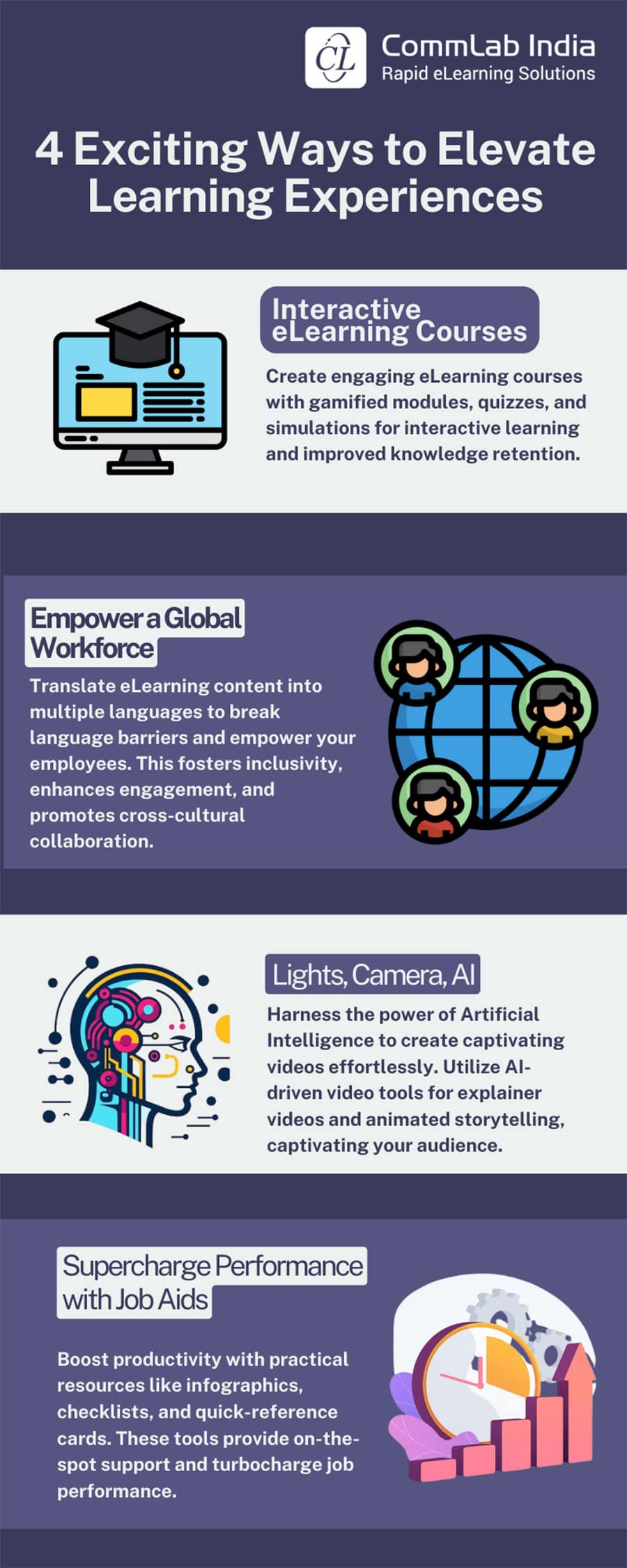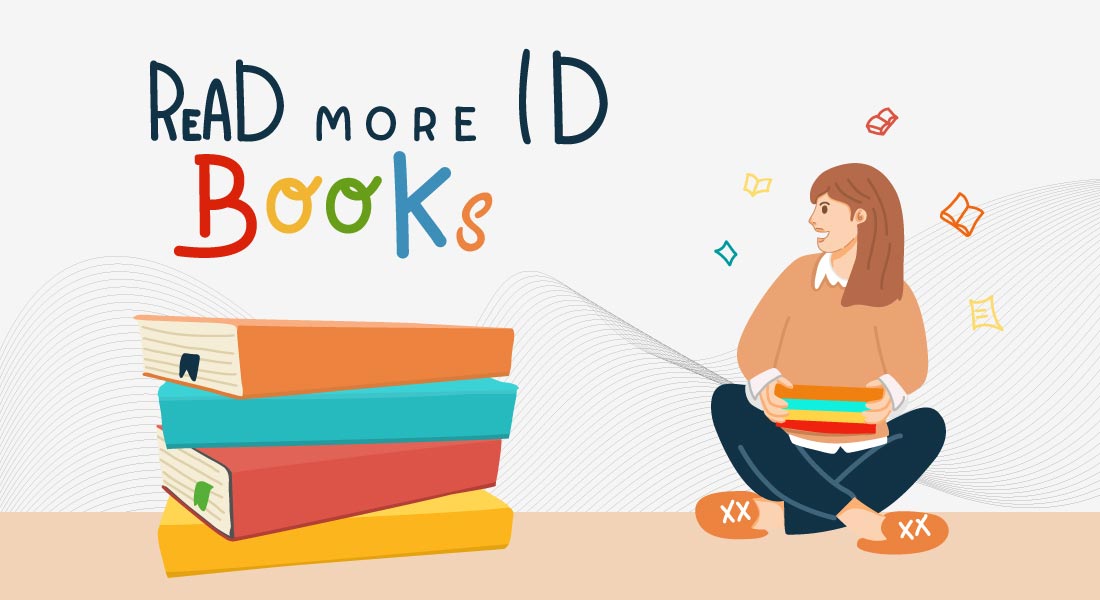Revealed! How to Use Rapid eLearning to Ace Corporate Training [Infographic]
![Revealed! How to Use Rapid eLearning to Ace Corporate Training [Infographic] Revealed! How to Use Rapid eLearning to Ace Corporate Training [Infographic]](https://blog.commlabindia.com/hubfs/blogs/rapid-elearning-ace-corporate-training-infographic.jpg)
In today's fast-paced business environment, traditional training methods can be cumbersome. And Rapid eLearning serves as the solution. This approach prioritizes agility and helps create quick and engaging, learner-centric online courses. Owing to these qualities, rapid eLearning is becoming increasingly popular among L&D leaders.
Rapid eLearning is a Popular Choice for Corporate eLearning Development
Here are the top 5 benefits it offers:
- Cost-Effective Development
- Quick Turnaround
- Enhanced Engagement
- Flexibility and Adaptability
- Reduced Downtime
Let us now discuss the key stages involved in the process of rapid eLearning development:
Rapid eLearning Development: Pre-Production Planning
When it comes to rapid eLearning development, pre-production planning is key. This means taking the time to understand your audience, your learning objectives, and your content before you start developing your eLearning course.
Here are some key planning tips for eLearning success:
- Know Your Audience: Understand your learners' needs, styles, and motivations to create targeted content.
- Set Clear Objectives: Define specific, measurable goals for your learners to achieve.
- Organize Content: Break topics into digestible sections for easy learning.
- Use Reliable Sources: Ensure accuracy and currency of information by using quality resources.
Once you are done with the pre-planning, your next step will be to ponder and decide on the most suitable storyboarding strategy.
Rapid eLearning Development: Storyboarding Strategies
Storyboarding is a visual planning technique that conveys the flow, structure, and content placement in the undertaken project. Storyboarding for rapid eLearning is flexible and adaptable. It begins with a deep understanding of the content, followed by designing engaging ways to present it for effective learning.
Here are some storyboarding strategies:
- "I Do, We Do, You Do" Approach: Start by presenting new information ("I do"), then guide learners in its application ("we do"), and finally let them complete the task independently ("you do").
- Demo and Practice Method: Demonstrate a task or process, guide practice, and then allow independent practice.
- Problem-Based Learning Approach: Present a challenge or problem for learners to solve, often through interactive scenarios or game-based activities.
- Case Study Approach: Provide information about a real-life situation and ask learners to apply their knowledge to the case.
- Scenario-Based Learning Approach: Similar to the case study, learners face a scenario and must apply their acquired knowledge to navigate it.
Regardless of your chosen approach, ensure content is engaging, relevant, and skill-building to drive learner success. Once you decide on the storyboarding strategy, you should start focusing on the development tactics.
→ Download Now: A 360° View of Rapid eLearning [Infographic]
Rapid eLearning Development: Development Tactics
Based on the storyboard prepared, you will have to use the right authoring tools and templates and start developing the eLearning module. Here are some tips for efficient eLearning development:
- Collaborate with SMEs: Work closely with subject matter experts (SMEs) for high-quality, relevant content, and seek their feedback throughout.
- Leverage Existing Content: Use existing materials whenever possible and consider templates for efficient content creation.
- Keep Modules Focused: Maintain short, focused eLearning modules to enhance information retention and learner engagement.
- Use Multimedia: Enhance engagement with multimedia elements like audio, video, and simulations.
There are several different formats for rapid eLearning development to skyrocket your corporate training initiatives. Here's an infographic that talks about the top 4:
The next step is to perform QA and test the product at hand.
Rapid eLearning Development: Quality Assurance and Testing
For successful rapid eLearning development, prioritize QA and testing:
- Define Acceptance Criteria: Set clear criteria upfront to guide effective testing.
- Automate Testing: Streamline the process for consistency and time savings.
- Establish a QA Team: If feasible, have a dedicated team for test execution and issue reporting.
You have arrived at the last leg which involves incorporating feedback and launching the course.
Wrapping Up and Launching the Course
Here are the final considerations for launching your eLearning course:
- Thorough Testing: Ensure your course is free from technical issues, accurate, up-to-date, and logically structured before launch.
- Promotion: Effectively promote the course to your target audience through website landing pages, social media, or email campaigns.
- Ongoing Monitoring: Continuously monitor course progress to identify areas for improvement and ensure a positive learner experience.
Wrapping Up
Rapid eLearning development is a challenging but rewarding endeavor. By following the steps and using the formats discussed, you can craft an engaging and effective course that meets both your learners’ needs and organizational goals. Want to know how rapid eLearning boosts your training ROI?
Download our infographic!




![Rapid eLearning — How Does it Level Up Your Corporate Training [Infographic]](https://no-cache.hubspot.com/cta/default/59327/de52bfb0-a084-44af-bbf0-cd462dcbf6bf.png)
![The Pros and Cons of E-learning [Infographic]](https://blog.commlabindia.com/hubfs/Imported_Blog_Media/pros-cons-elearning-infographic.jpg)

